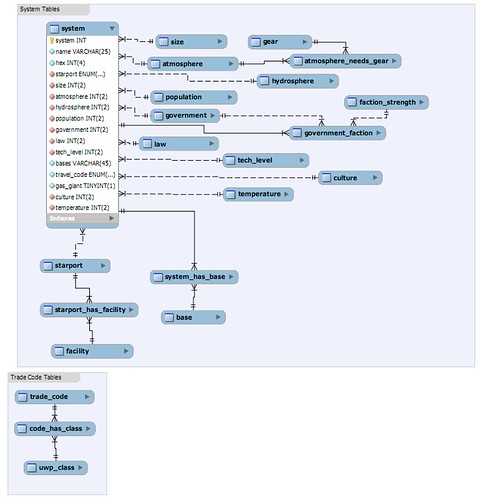So, after years of hearing about the game, and seeing the odd used book, I finally picked up Traveller (Mongoose in my case). And love it. I finally found myself in a local gaming group, they are willing to let me run a game, and my soon-to-be players want to try some role-playing outside of the context of swords and sorcery.
However, the idea of picking up decades' worth of history from OTU is slightly overwhelming. So, running a game IMTU it will be. MTU will be starting from scratch, sort of building it as my players explore, and tacking some of the history on later, and in intra-session prep. But a galaxy's worth of star systems (heck, a sector's worh!) is a lot of data to keep track of.
Good thing I like computers. And coding. And have been in need of an excuse to learn more complex SQL than
So I have taken it upon myself to concoct myself a MySQL database which will store store UWPs, star systems, subsectors, and sectors. And while I'm at it, tackle character (and thus NPC) generation and storage. And why not- how about ships?
I've learned a metric truckload of SQL in the past few days, and have made much progress including taking discrete system data the like of:
.. and making it into a UWP the like of:
Granted, I'm certain that the bulk of my SQL code is atrocious and ugly and probably stored in a manner that will paint me into a rebuilding-the-design-from-the-ground-up corner in a week or two.
However I'm nearly at the point where I will have an entirely SQL-based star system generator, so I thought I would come here to do two things:
Firstly, I'd like to offer to share my schemas with anyone who would be interested, and secondly, to ask if this wheel has been invented before and pick some brains on some things.
For example (and keep in mind I'm completely new to traveller), I just today actually took a look at how the hexes are numbered in a subsector or sector map. I was about to weep about the prospect of generating an arbitrary Jump-6 map for a given sctor until I finally noticed that, if the first hex in subsector A is 0101 and the last in subsector P is 3240, then the first two digits of the hex make a very nice X coordinate, and likewise the second two for Y. However, 0402 is 'southwest' of 0502, while 0302 is 'northwest' of 0402. This will be in interesting problem to solve. So too will be determining what systems lie within, say, Jump-4 of a given hex.
However, the idea of picking up decades' worth of history from OTU is slightly overwhelming. So, running a game IMTU it will be. MTU will be starting from scratch, sort of building it as my players explore, and tacking some of the history on later, and in intra-session prep. But a galaxy's worth of star systems (heck, a sector's worh!) is a lot of data to keep track of.
Good thing I like computers. And coding. And have been in need of an excuse to learn more complex SQL than
Code:
SELECT foo FROM bar WHERE baz = bletch;So I have taken it upon myself to concoct myself a MySQL database which will store store UWPs, star systems, subsectors, and sectors. And while I'm at it, tackle character (and thus NPC) generation and storage. And why not- how about ships?
I've learned a metric truckload of SQL in the past few days, and have made much progress including taking discrete system data the like of:
Code:
mysql> select * from system where id = 3;
+----+-----------+---------+-----+----------+------+------------+-------------+------------+------------+-----+------------+----------+-------------+-----------+--------------+
| id | subsector | name | hex | starport | size | atmosphere | hydrosphere | population | government | law | tech_level | bases | travel_code | gas_giant | culture_code |
+----+-----------+---------+-----+----------+------+------------+-------------+------------+------------+-----+------------+----------+-------------+-----------+--------------+
| 3 | NULL | Salaxis | 0 | C | 6 | 12 | 10 | 3 | 5 | 7 | 10 | Research | AMBER | 1 | 0 |
+----+-----------+---------+-----+----------+------+------------+-------------+------------+------------+-----+------------+----------+-------------+-----------+--------------+
Code:
mysql> call gen_uwp(3);
+---------+------+-----------+-------+-------------+-------------+
| Name | Hex | UWP | Bases | Trade Codes | Travel Code |
+---------+------+-----------+-------+-------------+-------------+
| Salaxis | 0 | C6CA357-A | R | Fl Lo Wa | AMBER |
+---------+------+-----------+-------+-------------+-------------+However I'm nearly at the point where I will have an entirely SQL-based star system generator, so I thought I would come here to do two things:
Firstly, I'd like to offer to share my schemas with anyone who would be interested, and secondly, to ask if this wheel has been invented before and pick some brains on some things.
For example (and keep in mind I'm completely new to traveller), I just today actually took a look at how the hexes are numbered in a subsector or sector map. I was about to weep about the prospect of generating an arbitrary Jump-6 map for a given sctor until I finally noticed that, if the first hex in subsector A is 0101 and the last in subsector P is 3240, then the first two digits of the hex make a very nice X coordinate, and likewise the second two for Y. However, 0402 is 'southwest' of 0502, while 0302 is 'northwest' of 0402. This will be in interesting problem to solve. So too will be determining what systems lie within, say, Jump-4 of a given hex.
Last edited:


 imtu-procs.sql.zip (8.7 KB, 0 views)
imtu-procs.sql.zip (8.7 KB, 0 views)